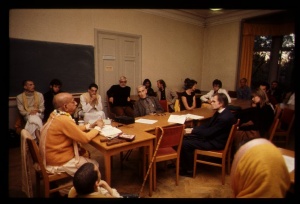CC Adi 5.83 (1975)

A.C. Bhaktivedanta Swami Prabhupada
TEXT 83
- ādyo 'vatāraḥ puruṣaḥ parasya
- kālaḥ svabhāvaḥ sad-asan manaś ca
- dravyaṁ vikāro guṇa indriyāṇi
- virāṭ svarāṭ sthāsnu cariṣṇu bhūmnaḥ
SYNONYMS
ādyaḥ avatāraḥ—original incarnation; puruṣaḥ—the Lord; parasya—of the Supreme; kālaḥ—time; svabhāvaḥ—nature; sat-asat—cause and effect; manaḥ ca—as well as the mind; dravyam—the five elements; vikāraḥ—transformation or the false ego; guṇaḥ—modes of nature; indriyāṇi—senses; virāṭ—the universal form; svarāṭ—complete independence; sthāsnu—immovable; cariṣṇu—movable; bhūmnaḥ—of the Supreme Personality of Godhead.
TRANSLATION
"The puruṣa is the primary incarnation of the Supreme Personality of Godhead. Time, nature, prakṛti (as cause and effect), the mind, the material elements, false ego, the modes of nature, the senses, the universal form, complete independence and the moving and nonmoving beings appear subsequently as His opulences."
PURPORT
Describing the incarnations and their symptoms, the Laghu-bhāgavatāmṛta has stated that when Lord Kṛṣṇa descends to conduct the creative affairs of the material manifestation, He is an avatāra, or incarnation. The two categories of avatāras are empowered devotees and tad-ekātma-rūpa (the Lord Himself). An example of tad-ekātma-rūpa is Śeṣa, and an example of a devotee is Vasudeva, the father of Lord Kṛṣṇa. Śrīla Baladeva Vidyābhūṣaṇa has commented that the material cosmic manifestation is a partial kingdom of God where God must sometimes come to execute a specific function. The plenary portion of the Lord through whom Lord Kṛṣṇa executes such actions is called Mahā-Viṣṇu, who is the primal beginning of all incarnations. Inexperienced observers presume that the material energy provides both the cause and the elements of the cosmic manifestation and that the living entities are the enjoyers of material nature. But the devotees of the Bhāgavata school, which has scrutinizingly examined the entire situation, can understand that material nature can independently be neither the supplier of the material elements nor the cause of the material manifestation. Material nature gets the power to supply the material elements from the glance of the supreme puruṣa, Mahā-Viṣṇu, and when empowered by Him she is called the cause of the material manifestation. Both features of material nature, as the cause of the material creation and as the source of its elements, exist due to the glance of the Supreme Personality of Godhead. The various expansions of the Supreme Lord who act to empower the material energy are known as plenary expansions or incarnations. As illustrated by the example of many flames lit from one flame, all these plenary expansions and incarnations are as good as Viṣṇu Himself; nevertheless, because of their activities in controlling māyā, sometimes they are known as māyika, or having a relationship with māyā. This is a verse from Śrīmad-Bhāgavatam (SB 2.6.42).